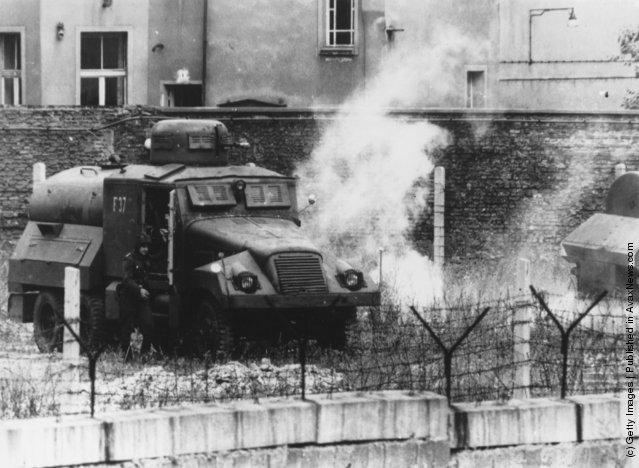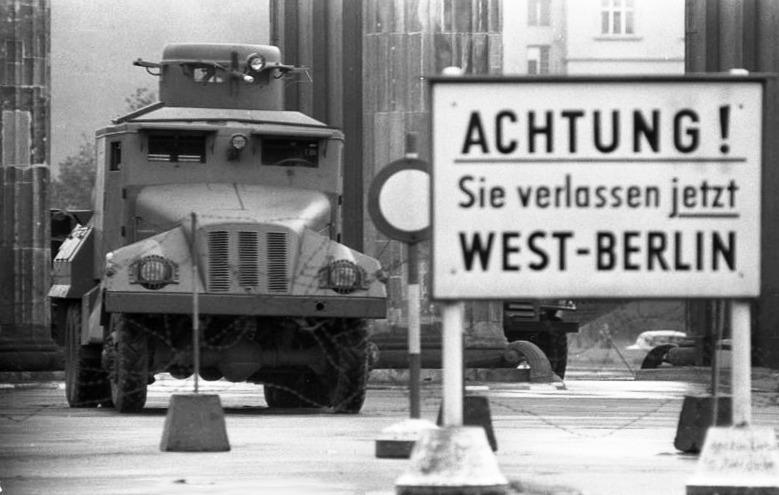Still looking for a proper designation but it appears to be the same as this vehicle photographed in 1960, looks like a water tanker outfitted for water cannon riot control.
I can honestly say it's not a standard military pattern Sovietvehicle that I have been trained to look out for on the battle field.
---------- Post added at 02:49 PM ---------- Previous post was at 02:45 PM ----------
G5 based SK-2 at the Brandenburg Gate during the building of the Berlin Wall.
The G5 has the three axles and can be all-wheel driven (6×6), however, the front axle can be switched off (6×4).
Engine: 6-cylinder diesel engine with 120 hp
Transmission: 5-speed-change gearbox with dog-type gearbox
Allowable utility weight: 5 tons
Maximum speed on road: 80 km / h
Maximum off-road: 40 km / h
Models / structures: dump truck, crane, suitcase (including workshop case), Flatbed with tarpaulin, tanker, water cannon, several fire trucks and others. The bodies were fitted out in many cases with other companies in East Germany.
The cab was manufactured in several different versions, such as a closed cab, cab with long cab (crew cabin with fire engines), cab with soft top and a cab with fold-down windshield.
The truck G5 and H6, which were built about the same time in Werdau, exhibit some identical modules. In order to improve the properties, especially for off-road use, equipped with a more powerful engine of advanced G5/3, but this was not built in the original series.
The main customers for these trucks were the Alert police or NVA and the People's Police. Vehicles of Combat Groups of the Working Class were used as water cannon, on 13 August 1961 during the construction of the Berlin Wall.
There were not present in sufficient quantities in the GDR trucks, decommissioned NVA G5s were later in Agricultural Production Cooperatives and more used in business, for example as a fuel transporter for Minol. The G5 was used by the fire service primarily as a fire engine (TLF 15) with crew cabin.
The G5 airfield sweeping machines from the VEB special vehicle factory in Berlin have a working width of 8 metres. (1959)
Goods for army use five tons payload usually sufficient and the important off-road, this corresponded to the needs of the industry only to a small extent. The ratio of costs and benefits did not match the given economic conditions. This meant that the G5 was rarely used with the advent of alternative trucks.Information

Warning: This is a relatively older thread
This discussion is older than 360 days. Some information contained in it may no longer be current.
- Knowledge Library

- MKL Entry of the Month
- Australia
- Austro-Hungarian Empire
- Canada
- Czechoslovakia
- Denmark
- Finland
- France/Belgium
- Germany
- Italy
- Japan
- Norway
- Russia
- South America
- Sweden
- Switzerland
- Turkey
- United Kingdom
- United States
- Yugoslavia
- Is my rifle authentic or a fake?
- Jay Currah's Lee Enfield Web Site
- On-line Service Records (Canada)
- Technical Articles/Research
- Forum
- Classifieds

- What's New?
-
Photo Gallery

- Photo Gallery Options
- Photo Gallery Home
- Search Photo Gallery List
-
Photo Gallery Search
- Video Club

- iTrader












 PM
PM


 Pretty funny...I have the old book on AFV and it's not even nearly in there. Remember, I was in when they taught all the old Cold War crap...never seen it!
Pretty funny...I have the old book on AFV and it's not even nearly in there. Remember, I was in when they taught all the old Cold War crap...never seen it!

